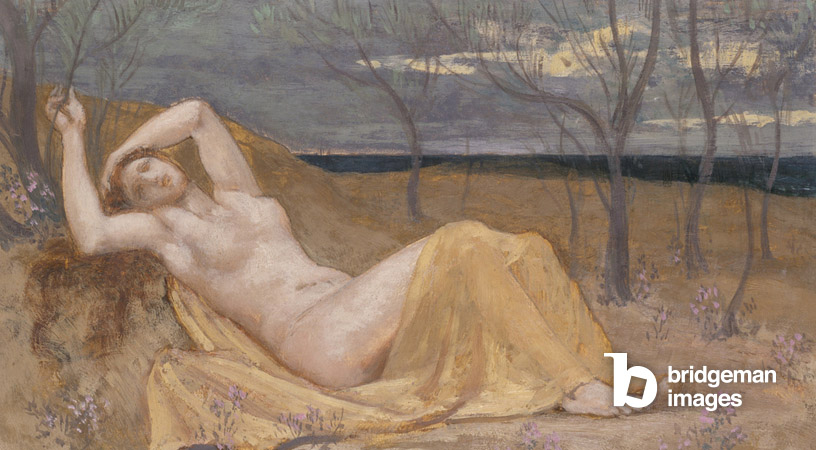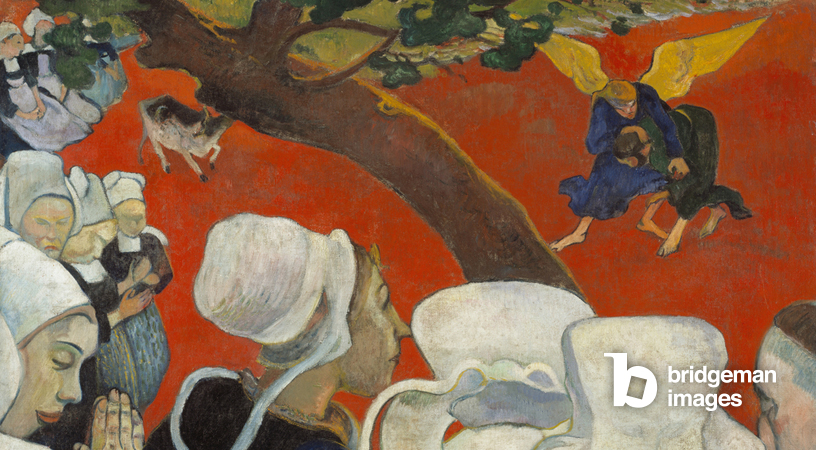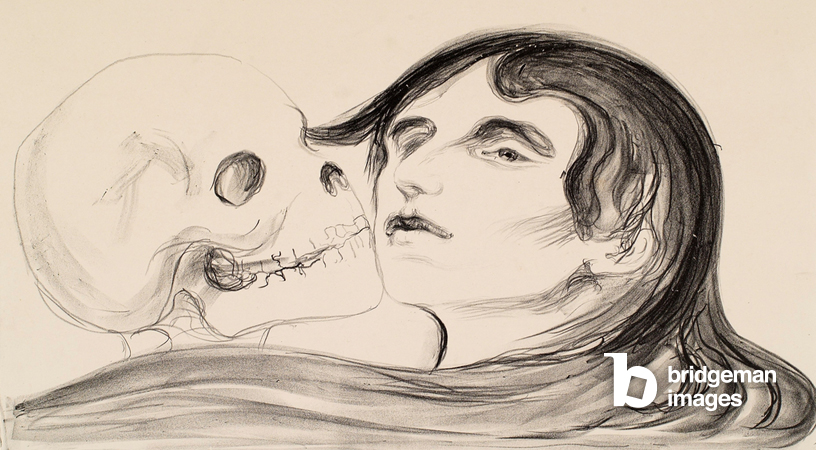Published 13/07/2023
Symbolism, was born in the late 19th century as a reaction against rationalist and materialist ideals. The artistic movement extended from literature to the fine arts. Favouring the subjective expression of emotions and ideas, it offered artists an unprecedented creative freedom.
View our selection of Symbolist works
How Does Symbolism Work?
In order to truly delve into symbolism, it's crucial to understand its core elements. So let's unlock the mystery of how symbolism functions on a fundamental level.
Understanding the Concept of Symbols and Their Meaning
A symbol serves as an abstract representation, standing in for an idea or concept that's often more complex than any single word can encapsulate. It transcends traditional language, offering depth and layers to a narrative or artwork. For example, if I mention the word "dove," you may picture a white bird. In literature or art though, this creature often represents much more. Taking on cultural and historical implications, doves frequently symbolize peace or innocence.
The beauty of symbols lies in their flexibility—they can mean different things in diverse contexts. A heart shape might evoke sentiments of love in one setting while representing life and vitality in another context based on cultural nuances.
Symbolic elements add richness to artistic expressions without making narratives verbose—an attractive economy of language if used adeptly.
The Role of Interpretation in Symbolism
Context plays a significant role when it comes down to deciphering symbols. Your understanding—what you infer from symbolic elements—hinges greatly upon your interpretation, which can vary with individual perspectives and cultural backgrounds.
Speaking about literature symbolism specifically: A writer incorporates symbolic meaning within their work not just as decorative additions but with intention; each supposed to elicit readers' thinking towards deeper understanding beyond literal text-world interactions.
Yet what’s interesting is that there isn't always one ‘correct’ way to interpret symbols—it’s largely based on personal reception shaped by unique life experiences and exposure.
Exploring the Connection between Symbols and Emotions
Symbols do more than just denote ideas; they are designed to evoke emotion—adding depth to our responses toward a piece of literature, art, music, among other forms of expression.
For instance, stormy weather employed as symbolic literary device often instills a sense of foreboding or impending trouble. The symbol here incites specific emotions, guiding readers on an affective journey through the text.
In essence, symbols are instrumental in provoking emotional responses which ultimately contribute to how we engage with and remember certain narratives or pieces of art.
So, next time you chance upon a piece of literature sprinkled with symbolism or an artwork layered with signs and symbols—pause, reflect. You'll find that these symbols, much like secret keys, open doors to deeper meanings and richer interpretations.
Types of Symbolism
When we delve into the cavernous depths of symbolism, we discover a colorful array of types. Some are as vivid as the hues on an artist's palette – such is color symbolism; some derive their essence from fauna – known as animal symbolism, and others rest in mundane objects around us exhibiting hidden meanings.
Color Symbolism and Its Significance in Different Contexts
Diving into color symbolism is much like stepping into a rainbow—each shade resonates with its own distinct vibe and symbolic meaning. Let's navigate this vibrant labyrinth:
- Red: A potent symbol associated often with emotions like passion, love, anger and danger.
- Blue: Radiates calmness, trustworthiness, depicting spiritual and physical tranquil.
- Green: Echoes growth, renewal, fertility- rightly used to represent nature.
- Black: Not just sartorial elegance but symbolizes mystery, death or evil.
From signaling emotions in literature to representing ideologies (like green in environmental movements), the use of color carries profound significance across different contexts.
Animal Symbolism and Its Representation in Various Cultures
In many cultures throughout history, animals have been looked upon not just as creatures sharing Earth but also laden with symbolic implications.
Take for instance serpents—they've frequently made appearances in religious texts & myths across the globe; viewed in Christianity as embodiment of deceit while worshipped for fertility & rebirth by ancient Egyptians.
The noble eagle soars high up till it becomes synonymous with supreme power & transcendence—fittingly chosen as United State's national emblem for its strength and freedom spirit.
These examples denote how animal symbolism functions differently within various cultural constructs yet contributes heavily towards enriching our literary device symbolism lexicon!
Symbolism Of Common Objects And Their Hidden Meanings
Even the most ordinary items can be vessels for a wealth of symbolic meaning. For example:
- Paths: Often a metaphor for one's life journey.
- Mirrors: Symbolize self-reflection and truth.
- Bridges: Suggest crossings, transitions, or overcoming obstacles.
In essence, symbolism transforms these common entities into potent literary tools that add depth to narratives and help convey complex ideas with nuance and subtlety. Thus, while exploring the vast realm of symbolism in literature and art, never underestimate the power hidden beneath the ordinary.
Symbolism in the Visual Arts
Although it was initially rooted in literature, Symbolism quickly became associated with a younger generation of painters who sought to reject the conventions of Naturalism. Symbolist painters believed that art should reflect an emotion or an idea rather than objectively and quasi-scientifically representing the natural world, as Realism and Impressionism did. By reconnecting with the personal expressiveness advocated by the Romantics of the 19th century, they considered the symbolic value or meaning of a work of art to arise from recreating emotional experiences in the viewer through colour, line, and composition. In painting, Symbolism represented a fusion of form and feeling, of reality and the artist's inner subjectivity.
The Precursors of Symbolism: Dreamlike Worlds and Enigmatic Figures
In an article on Paul Gauguin published in 1891, Albert Aurier provided the first definition of symbolism as an aesthetic, describing it as "the subjective vision of an artist expressed through a simplified and non-naturalistic style," and hailing Gauguin as its leader. However, the foundations of pictorial Symbolism were laid as early as the 1870s by an older generation of artists such as Gustave Moreau, Puvis de Chavannes, Odilon Redon, Eugène Carrière, Arnold Böcklin, and Edward Burne-Jones.

Examples of Symbolism in Literature and Art
Symbolism is a versatile literary device frequently used across myriad artistic mediums to communicate deeper meanings. Sweeping from the finest contours of classic literature, through awe-inspiring brush strokes in art, to the harmonious chords and lyrics of film and music, symbolism shapes narratives far beyond the literal.
Analyzing Famous Literary Works with Symbolic Elements
Understanding word symbolism opens a treasure trove of profound layers within well-loved texts. A classic example is Harper Lee's "To Kill a Mockingbird," where the mockingbird represents innocence and goodness marred by injustice. In George Orwell’s "Animal Farm", animals stand as symbols for political figures and ideologies; this is why it's often said 'literature symbolism' carries much weight.
Apart from symbols within stories, 'symbolism sentence' themes are also degrees into character names or places that subtly encode underlying currents. Hawthorne’s "Scarlet Letter" uses color symbolism with red denoting sin while white signifies grace.
Coming to modern context, Suzanne Collins' "The Hunger Games" examines flower symbolism with the katniss plant suggesting survival amidst adversity – just like its namesake character.
By delving into symbolic elements of such works, readers uncover extra dimensions embroidered delicately beneath surface narratives.
Examining Iconic Artworks with Symbolic Representations
Now transitioning from literary symbolism to arts symbols - symbolic artists painstakingly intertwine exquisite details. Let's look at Van Gogh's iconic "Starry Night." He uses vibrant swirls representing his inner turmoil; his longing for solace echoed against an expanse speckled with bright stars symbolizing hope or perhaps unattained dreams.
Another potent instance springs from Grant Wood’s “American Gothic". Here, an austere couple flanks a pitchfork signifying hard work while their house personifies wishful assertion of American rural idealists during the Great Depression.
When we evaluate such vibrant 'symbolism paintings', it lends an understanding of the artist’s psyche and societal nuances prevalent during their time.
Case Studies on the Use of Symbolism in Film and Music
In addition to literature and art, symbolism enriches film and music narratives. Consider Alfred Hitchcock's "Vertigo," where spiral motifs symbolize psychological decline, or James Cameron's “Titanic,” using the colossal ship as a symbol for human arrogance challenging mother nature.
Then again, you can't overlook music while discussing artistic symbolism. Pink Floyd's "The Wall" employs bricks as symbols of isolation; The Rolling Stones' song "Paint It Black", uses color symbolism portraying despair and desolation.
Through these case studies, it is evident that employing symbolic representations allow artists greater latitude to convey intense emotions or conceptual themes.
Symbolism operates by subverting our cognitive processes, triggering emotional responses by imbuing layers of meaning into everyday words, settings, characters or events. By illuminating hidden depths within commonplace components of arts and literature, it engages audiences at deeper intuitive levels - making each experience unique and interpretative.

Symbolism Across Cultures
Varieties in symbolic traditions, means of interpretation, and the overall understanding dramatically differ across cultures. Exploring these involves unraveling woven threads of historical context, tradition, belief systems, literature symbolism, and more.
Symbolic Traditions in Different Cultures Around the World
Symbolic traditions vary widely worldwide; let's dip our toes into some prominent cultural symbols.
In Japanese culture, the "Cherry Blossom," or "Sakura," symbolizes the transience of life due to its short blooming periods. It represents mortality and the beauty of a transient existence. Whereas, Greek mythology introduces us to the "Olive Branch," a symbol that communicates peace and reconciliation directly derived from ancient legends.
The Native Americans value animals as integral parts of their symbolic elements - for example, an owl signifies wisdom while a bear symbolizes strength.
Meanwhile in Hindu philosophy and beyond, "AUM" or "OM" is considered a sacred sound resonating symbolic meaning. It's seen as encompassing all words, all sounds in human language making it one richly wrapped in mysticism.
Cultural Variations in Interpreting Symbols
Cultural variation also plays a significant role in interpreting symbols. Consider a snake's contrasting literary symbolism: western cultures typically view snakes with trepidation (considered devious creatures), whereas Eastern ideologies often associate them with fertility or even immortality - marked difference indeed!
Let’s take colors into consideration next. Red carries different connotations based on cultural perspectives – associated with luck and prosperity for the Chinese yet indicative of danger or passion in many Western societies.
Cross-cultural Comparisons of Symbolic Meanings
Cross-cultural comparisons provide intriguing insights into how various communities perceive symbols differently. An interesting case is number 13-dubbed unlucky largely within Western superstitions but seen as auspicious among people practicing Sikhism.
Similarly engaging cross-cultural comparison lies within the symbol of a lion. In Western cultures, it is emblematic of strength, majesty and bravery, often termed “King of the Jungle.” Yet in Chinese culture, apart from being bold and powerful, they are seen as symbolic guardians warding off evil spirits.
Embarking on this journey into understanding symbolism across cultures bewilderingly unveils both contrasts and convergences in these interpretations; making one thing profoundly clear: symbols aren't universal but multivocal, their meanings markedly moulded by the cultural context they exist within.
How to Use Symbolism Effectively
The ability to utilize symbolism effectively can enhance the depth and resonance of your work, be it in writing, art, or other forms of expression. In this section, you will learn various techniques to incorporate literary device symbolism seamlessly into your expression.
Techniques for Incorporating Symbolism into Writing, Art, and Other Forms of Expression
- Know Your Audience - The comprehension of a symbol may vary among different audiences. Knowing who you are communicating with is crucial to make sure your message gets across accurately.
- Use Cultural References: Often symbols are born from cultural contexts or historical situations. Drawing on these familiar elements can help create accessible yet profound symbolism.
- Intertwine With Emotional Themes: Affective themes enhance the connection the reader or viewer has with a symbol. Love, justice, freedom – use such universally felt emotions as an underlying theme for your symbols.
- Maintain Consistency: Once a symbol is introduced and its significance is established within a narrative context ensure its definition stays consistent throughout.
Now that we've identified some reliable techniques let's take a look at how we might convey symbolic messages without being too glaring.
Tips For Conveying Symbolic Messages Without Being Too Explicit
Blending subtlety with clarity can be quite the balancing act when utilizing potent tool like literature symbolism but here are few methods which could be employed:
- Imagery: Instead of directly stating what your symbol represents, paint a picture around it using evocative descriptions and imagery.
- Repetition: Reinforce your symbol by repeating it throughout the piece subtly under varying circumstances while maintaining its central meaning intact.
- Contrast: By placing symbols against contrasting elements in the storyline or artwork magnifies their presence without shouting out their meanings loud.
A note-worthy aspect of effective use of symbolism also lies discretely tucked within notion of subtlety.
The Power of Subtlety and Subtle Symbolism
Subtlety carries immense power. It allows symbols to gently infiltrate the audience’s consciousness, making their ultimate realization more impactful. It’s like a quiet revolution – it changes the landscape without drawing unnecessary attention until the shift is complete.
- Understatment: The understated symbol can have profound effects as its modest appearance conceals deeper associations.
- Hidden in Plain Sight: This technique involves embedding symbolism into everyday objects or common scenarios, allowing them to be recognized upon careful observation or reflection.
Remember, an instance of successful symbol use involves underlining your overall narrative rather than dominating it. Keep in mind balance, build rich contexts around your symbols and let subtlety do its magic!

The Impact and Influence of Symbolism
Symbolism, as a literary device symbolism or an aspect of art, embraces profound influences, leaving lasting legacies through the works that employ it. Whether subtle or glaringly evident, the effect of symbolism is extensive and far-reaching.
The Legacy of Famous Works That Utilized Symbolism
Some of our most cherished literary pieces and artworks showcase brilliant uses of symbolism. From Moby-Dick's ivory-colored behemoth symbolizing numerous facets of life to Plato's Cave metaphor illuminating his philosophy, the power to provoke thought using symbols cannot be understated.
George Orwell’s ‘Animal Farm’ offers iconic use of animal symbolism, where pigs are not merely animals but symbolic representations reflecting human greed and power lust. Thanks to effective utilization of this symbolic elements technique, Orwell's work endures as a profound critique on totalitarian regimes.
And then there's F .Scott Fitzgerald’s 'The Great Gatsby.' He masterfully paints word symbolism into various items like Dr T.J Eckleburg’s eyes signifying God's omnipresence in human morality or green light epitomizing hope.
Such famous literature symbolism examples impart a legacy illustrating how masterfully-employed symbols can cause ordinary prose to deeply resonate with readers and reveal layers rich in thematic depth.
Contribution to the Development and Evolution of Artistic Movements
Symbolist painters from the French symbolism art era such as Gustav Klimt internalized the notion that subjectivity was key in viewing and interpreting their work—an idea borrowed from literary device symbolism. Their influence spurred other movements like surrealism and expressionism which further utilized its potential for conveying subjective realities.
In another realm, cinema – Alfred Hitchcock introduced potent symbolic qualities into filmmaking during the 20th century. His strategic use of birds triggered specific emotions creating unforgettable cinematic moments – indeed proving him an essential figure shaping modern cinematography techniques.
Historical symbolism also influenced music, with classical composers like Richard Wagner embedding symbolic motifs in their compositions. Later on, folk and rock musicians employed symbolism to craft narratives, using music as a medium for social commentary.
Influence on Modern-Day Literature, Art, and Design
Fast forward to modern-day literature; symbols continue adding depth and nuance – harboring meanings which transcend literal contexts. Norwegian novelist Jo Nesbo masterfully utilizes the harrowing scenery of Norway's icy landscapes symbolising the darker aspects of humanity.
Symbolism's influence also extends into contemporary art – artists such as Cindy Sherman employ everyday objects to challenge conventions about identity or beauty norms. Symbolic figures appear frequently in her photos revealing a complex critique of society.
In design, logos often incorporate iconic symbolism - Apple Inc’s famed apple logo is a legendary example of intentionally invoking knowledge symbolism highlighting how they stand apart from tech companies through unique vision.
From an age-old practice to its current ubiquity across various disciplines – it is evident that symbolism holds related power to communicate complex ideas discreetly. Therefore, being well-versed in reading symbolism becomes crucial in interpreting today's culture and arts effectively.

Symbolism in Everyday Life
Welcome to the nuanced world of symbolism that exists right around us! In this segment, we delve deep into how symbols and symbolic elements dance in the orchestra of our day-to-day existence.
The Presence of Symbolism in Everyday Objects
Do you ever stop and ponder about familiar objects around you? Each item is subtly engaging an unspoken conversation with us through their unique symbolism.
To elucidate, consider a mirror – while essential for grooming, it has multiple symbolic interpretations across cultures, representing truth, self-awareness or vanity. Alternatively, the symbol definition in the literature usually veers towards introspection and revelation.
Likewise, consider a humble key. As per dictionary symbolism, it is often seen as a symbol of authority, control and access to something valuable - prompting thoughts about unlocking doors but also potential opportunities. This kind of everyday word symbolism touches our life unknowingly.
In effect, common items hold a massive treasure trove of symbolism that can be metaphorically ‘unlocked.’ By reading symbolism embedded in everyday objects like these ones, we can enrich our understanding of the world surrounding us.
The Use of Symbols in Advertising, Branding and Marketing
If you have spent some time noticing advertising campaigns or even branding designs, you’ll realize they are nothing short of masterpieces in persuading human psychology by tactfully using imagery loaded with symbolism. Apple Inc.'s logo for instance is essentially an apple with a bite taken out; arguably signifying knowledge or innovation – appealing to their audience’s aspirations.
Advertisers deftly use colour symbolism too when designing logos or products. Green might invoke feelings associated with nature and serenity whilst Red could stir up energy and passion. Brands utilize this subconscious association between colours and emotions to foster an association with their product/service.
Remember McDonald's golden arches or Nike's swoosh? They are symbolic artists who have used simple yet impactful symbols to carve out a unique branding identity.
So, whether it’s adverts playing on symbolic meanings or brands embracing symbol art definitions for creating visually compelling narratives, the world of marketing indeed heavily thrives on symbolism.
.jpg)
How Symbolism Shapes Our Perception and Understanding of the World
Perhaps unperceived by many, the ubiquity of symbols influences our interaction with reality, shaping our perception and understanding of our environment. This is not limited to literature symbolism or symbolism in art; signs and symbols are incorporated into societal constructs as well.
We learn to link traffic signals' colours with specific commands at a very young age: green means go while red means stop! National flags serve as symbolic representations radiating sentiments of patriotism and belongingness.
Furthermore, universally recognized symbols like peace sign ☮️ and heart shape ❤️ encode profound emotions beyond a few simple lines and curves. Human society has always used symbols for expressing intricate ideas more efficiently - akin to a linguistic shortcut for complex thoughts!
Whether it's literary device symbolism enabling deeper comprehension of a story or symbols facilitating communication across language barriers, symbolism imbues life with richness and dimension that would be otherwise hard to attain. It starts engaging dialogue among ourselves, between cultures & societies which ultimately helps us to connect & understand each other better!
Embracing this undercurrent of symbolism not only makes daily life fascinating but also enables us see ordinary things from an entirely fresh perspective.
View our selection of Symbolist works
Please feel free to reach out to our team; we are always happy to assist you in your research, with no obligation or additional cost.


